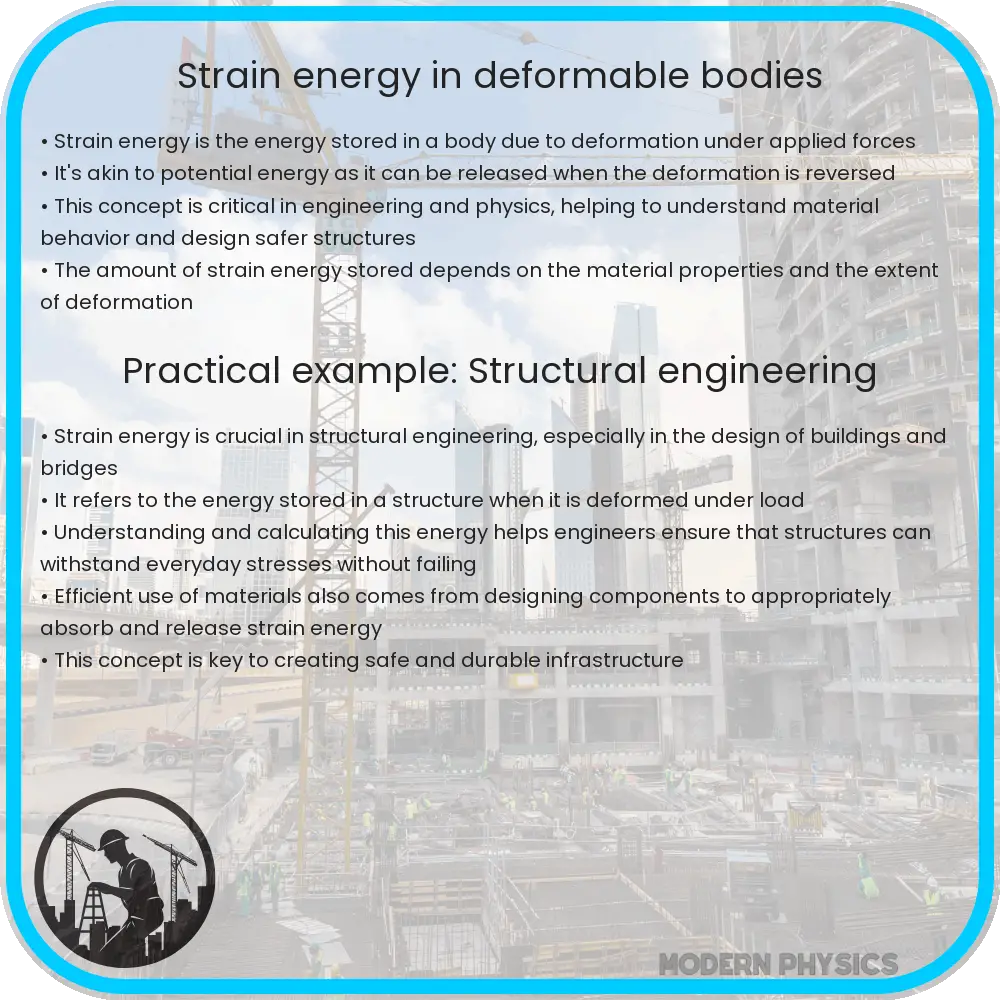Explore the essentials of strain energy, its calculation, and diverse applications in material science and structural engineering.

Understanding Strain Energy: An Essential Concept in Mechanics
Strain energy is a fundamental concept in the field of mechanics, particularly important in material science, structural engineering, and mechanical design. It refers to the energy stored in a material or system due to deformation under applied forces. Understanding strain energy is crucial for analyzing the resilience and durability of materials and structures.
Key Principles of Strain Energy
The concept of strain energy is rooted in the principles of elasticity and deformation. When a material is subjected to stress, it deforms. This deformation, within the elastic limit, is where strain energy is stored. The energy is released when the force causing the deformation is removed, allowing the material to return to its original shape.
Calculation of Strain Energy
Strain energy can be quantified using various mathematical models, with the most common being based on Hooke’s Law for elastic materials. The formula for calculating strain energy (U) in a linearly elastic material is given by:
U = (1/2) * stress * strain * volume
Or, using Young’s modulus (E) and the cross-sectional area (A), it can be expressed as:
U = (1/2) * (force2 * length) / (E * A)
Uses of Strain Energy
Understanding and calculating strain energy has several practical applications:
- Material Testing: Strain energy concepts are used to test the strength and elasticity of materials. This helps in determining suitable materials for various engineering applications.
- Structural Analysis: In civil engineering, strain energy calculations aid in designing structures that can withstand loads without excessive deformation or failure.
- Energy Absorption Devices: The ability of materials to store and release strain energy is exploited in designing devices like shock absorbers and vibration dampers.
By understanding and utilizing the principles of strain energy, engineers and scientists can enhance the performance and safety of materials and structures in various fields.
Advanced Aspects of Strain Energy
While the basic understanding of strain energy is rooted in Hooke’s Law, advanced mechanics introduces more complex scenarios. Non-linear elasticity, plastic deformation, and viscoelastic materials present more challenging cases for strain energy analysis. For these materials, the strain energy is not simply proportional to the square of the deformation, and specialized mathematical models are employed for accurate calculations.
Strain Energy in Dynamic Systems
In dynamic systems like rotating machinery or vehicles, strain energy plays a crucial role in vibration analysis. The energy stored in a system during one part of a vibration cycle can be released in another, affecting the system’s dynamic behavior. Engineers use strain energy concepts to design systems that minimize undesirable vibrations, enhancing efficiency and longevity.
Environmental and Economic Implications
The efficient use of materials, guided by strain energy analysis, has significant environmental and economic benefits. By selecting materials that optimally store and release energy, engineers can reduce material usage and waste, leading to more sustainable designs and lower production costs.
Conclusion
Strain energy is a critical concept in the field of mechanics, offering valuable insights into the behavior of materials and structures under stress. Its application ranges from material testing and structural analysis to the design of dynamic systems and energy absorption devices. Advanced aspects of strain energy, including non-linear behavior and dynamic systems analysis, further extend its relevance in modern engineering. The understanding and application of strain energy principles are not only essential for ensuring the safety and efficiency of structures and machines but also play a significant role in promoting sustainable engineering practices. As technology evolves, the role of strain energy in innovative design and material science continues to grow, making it a key area of study and application in the field of engineering.
